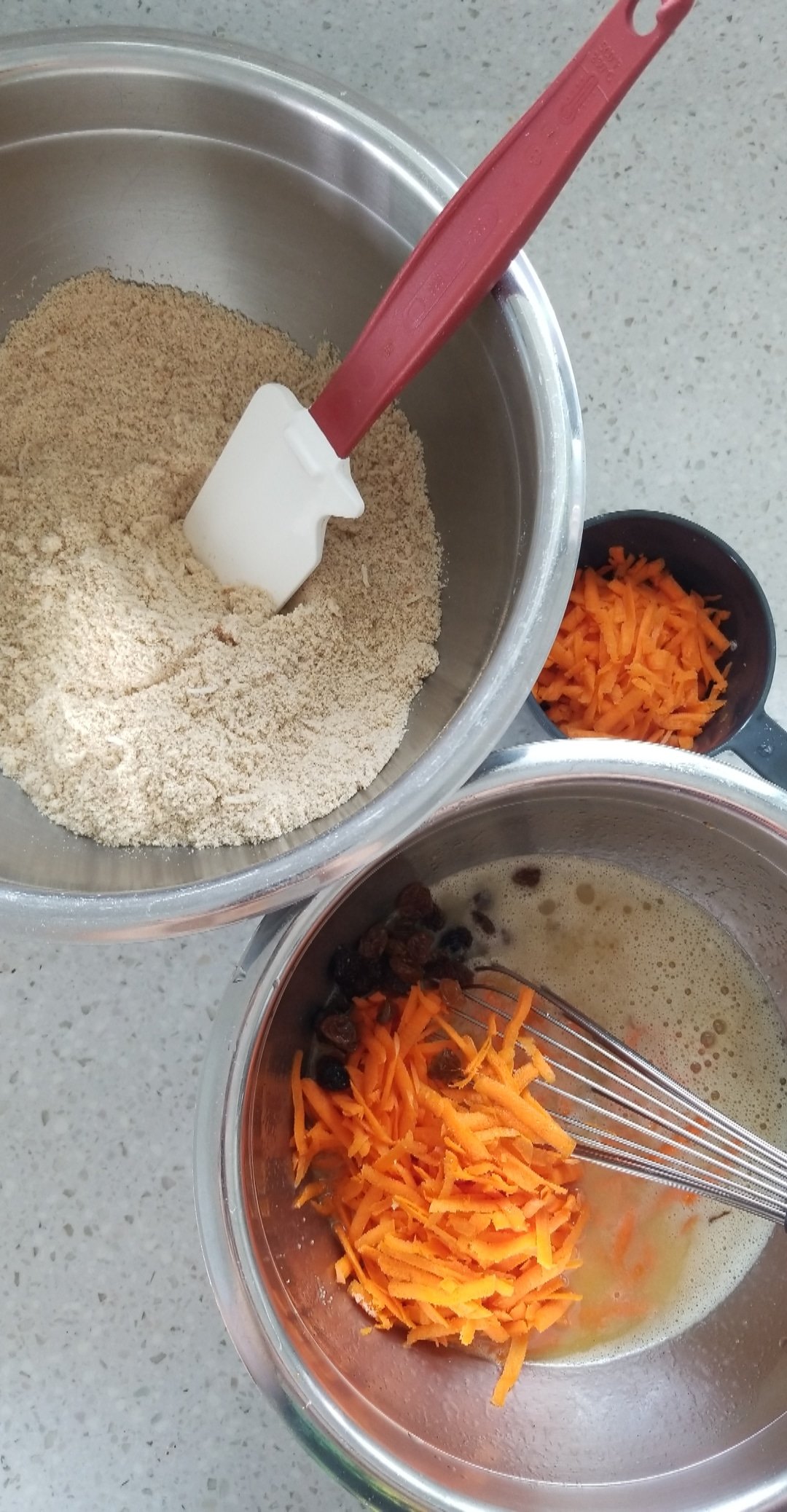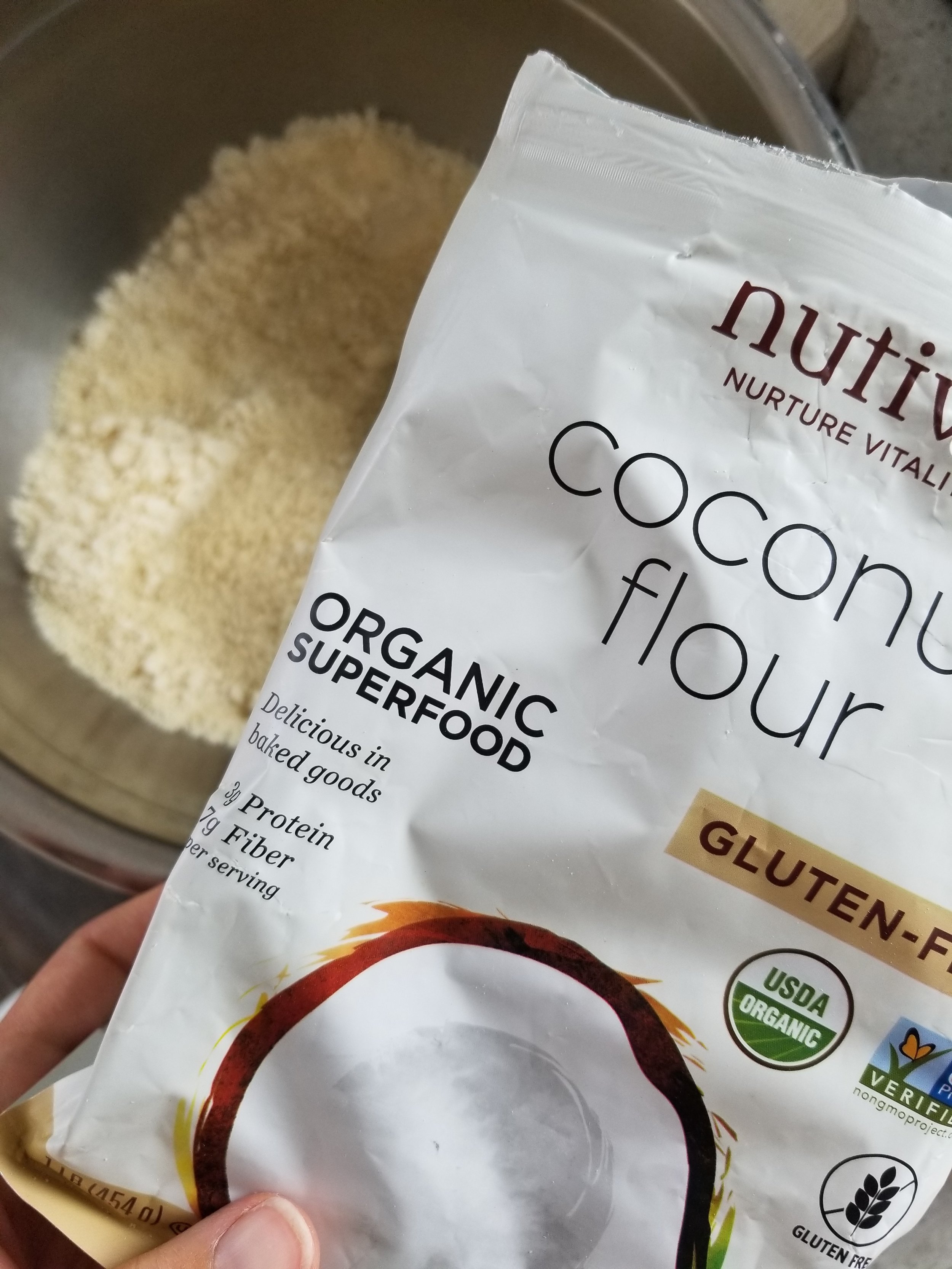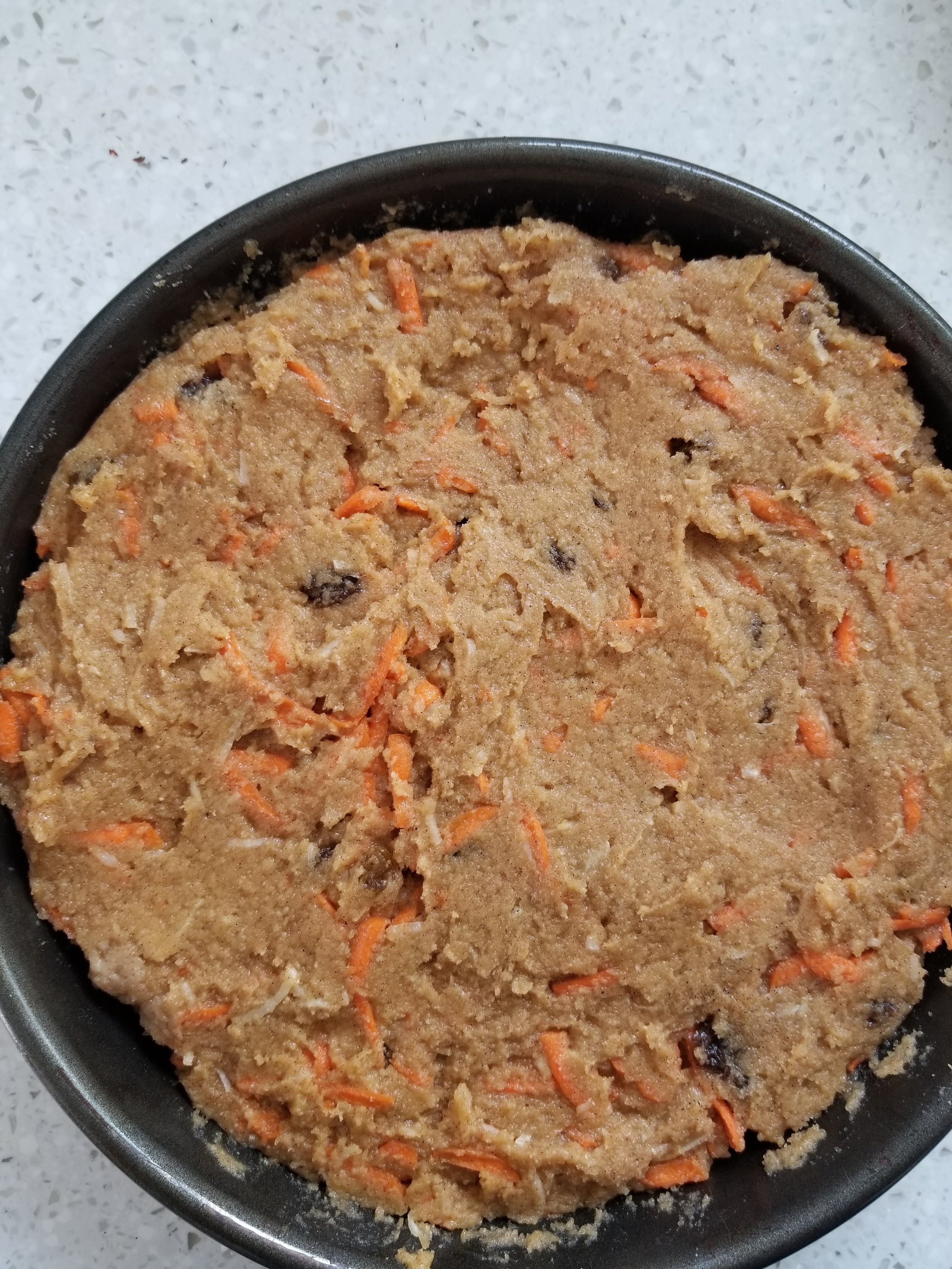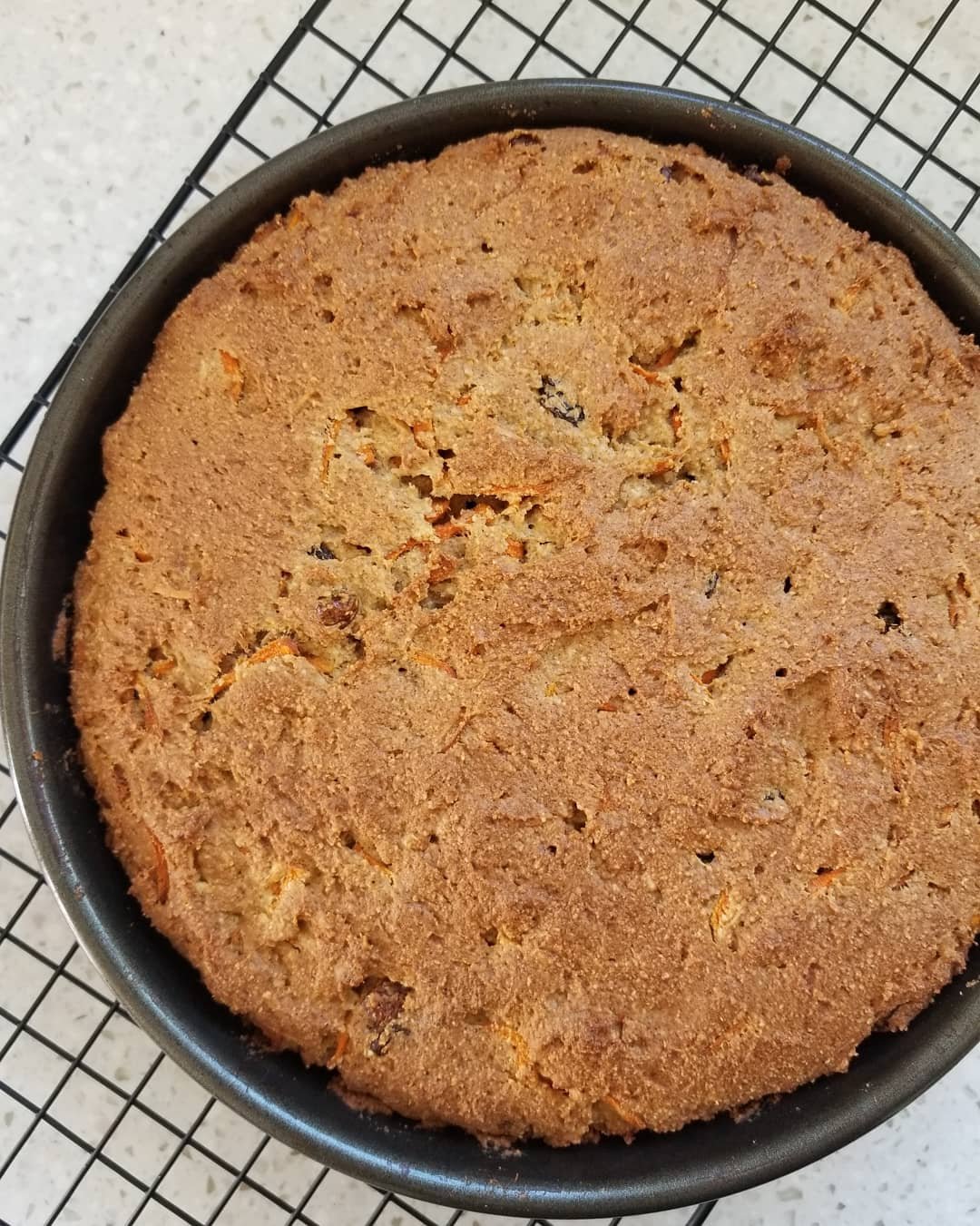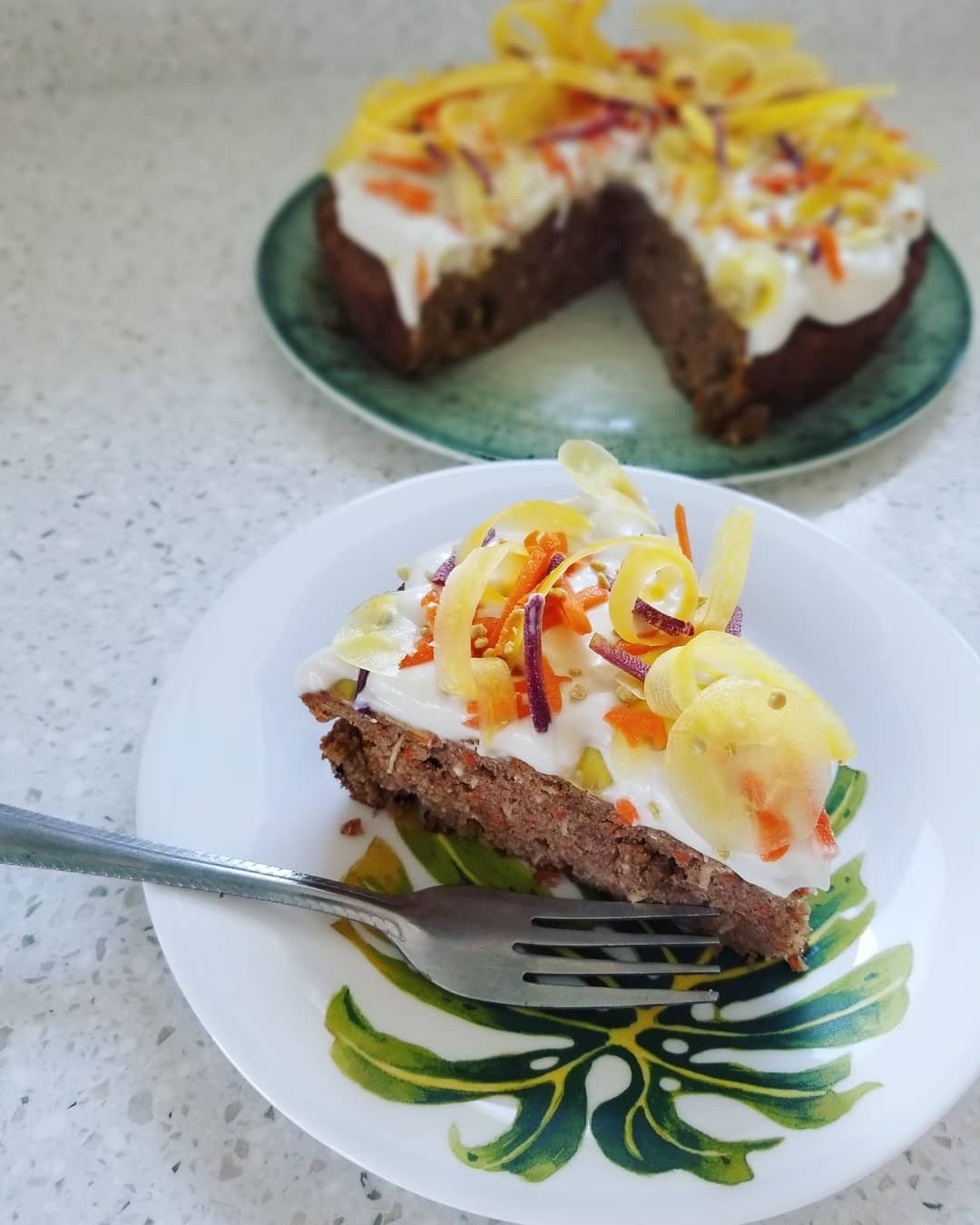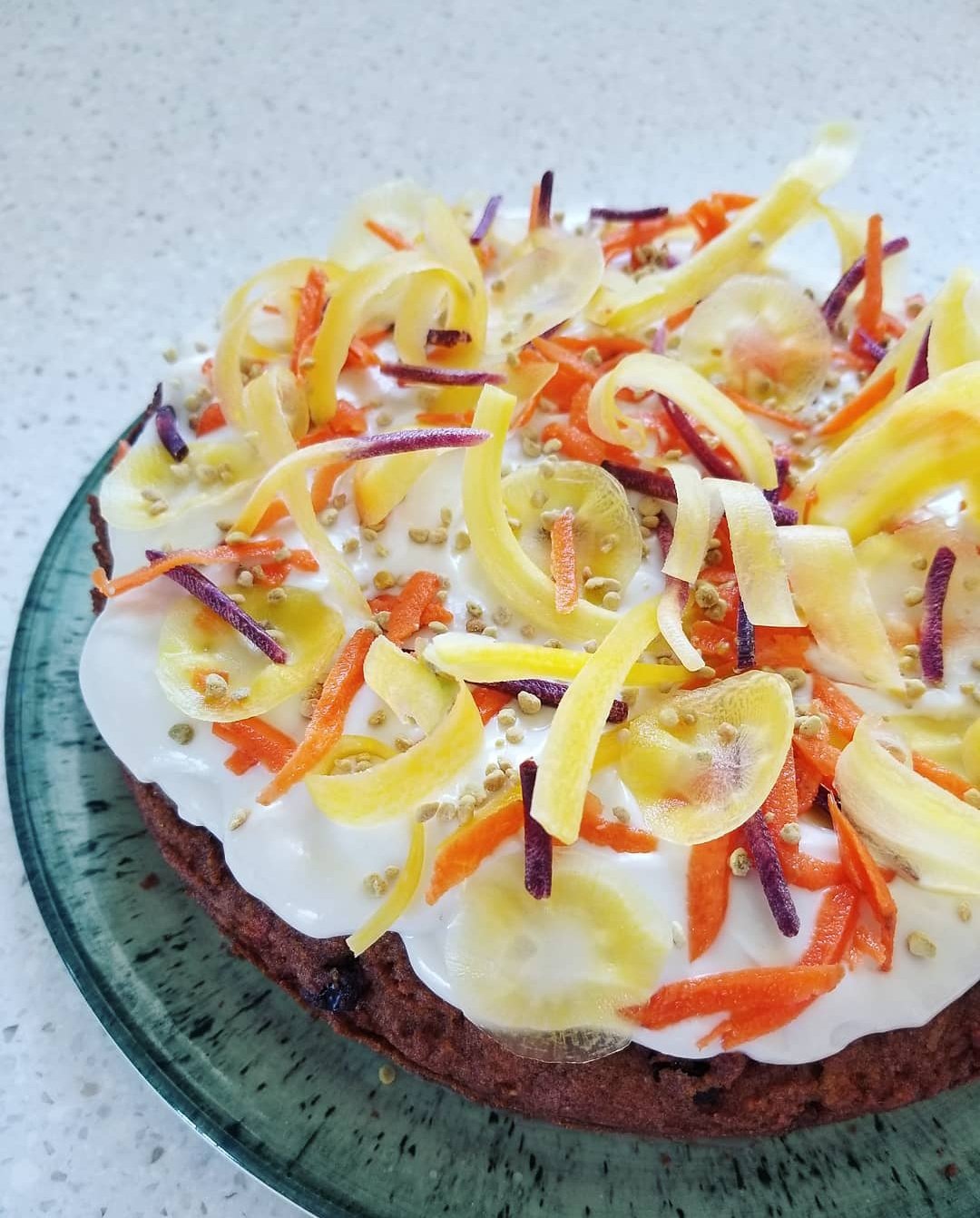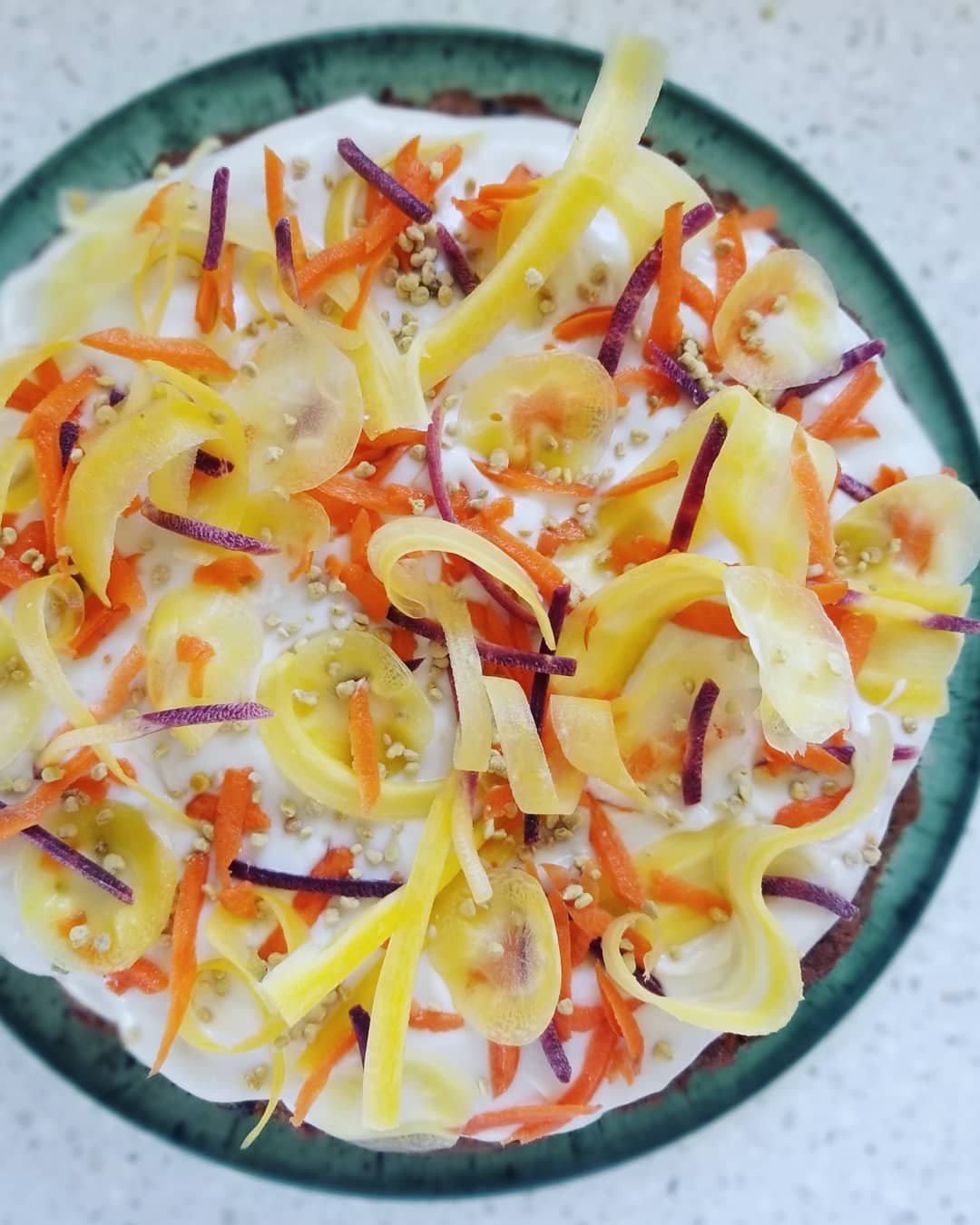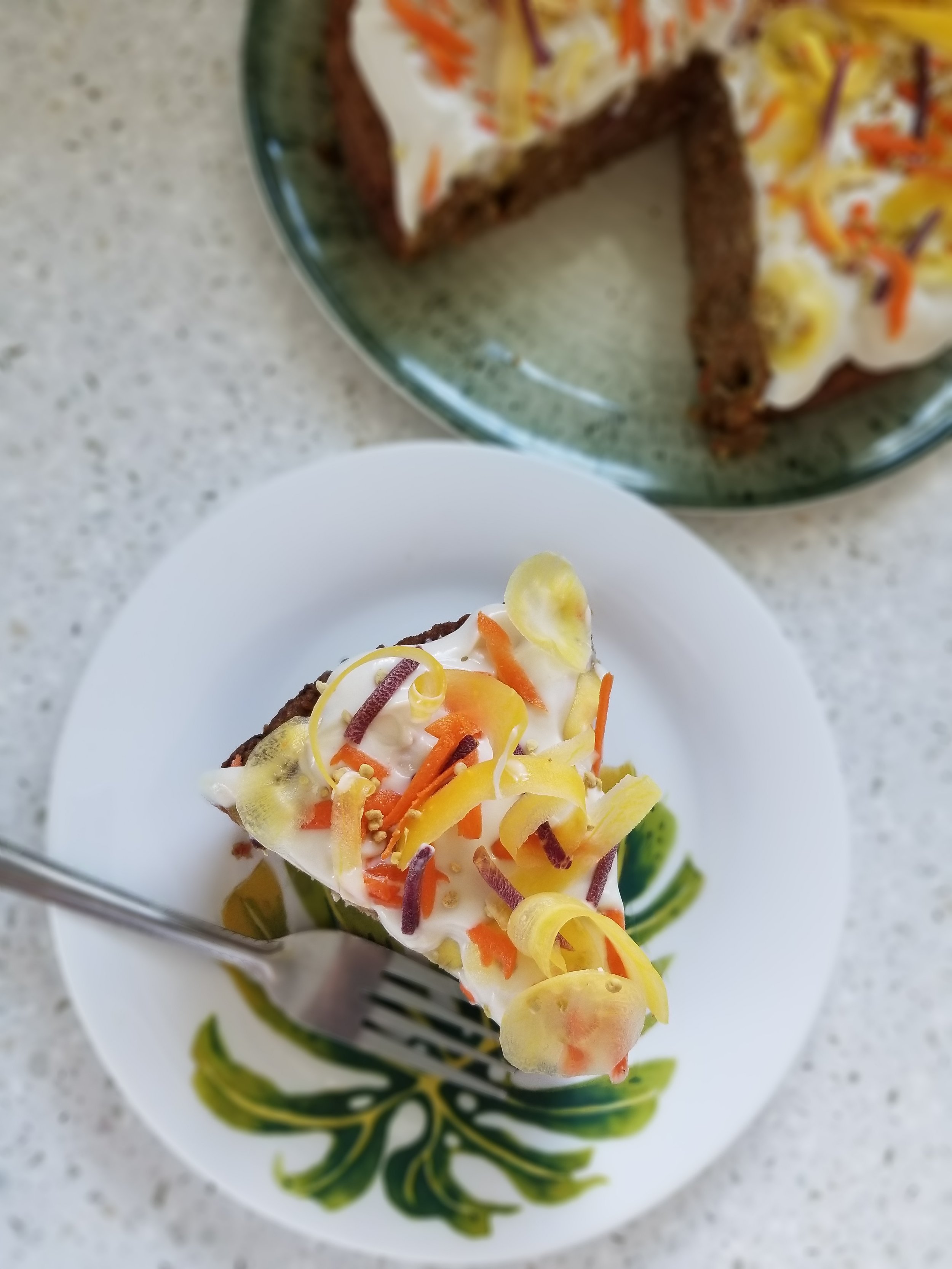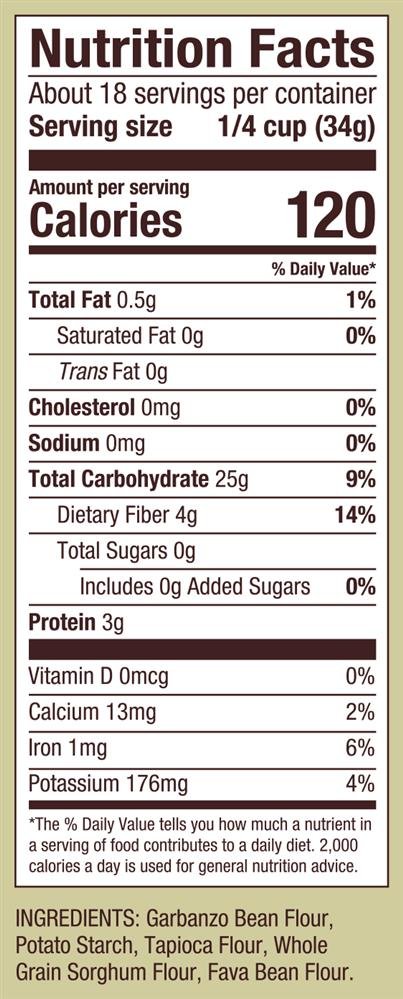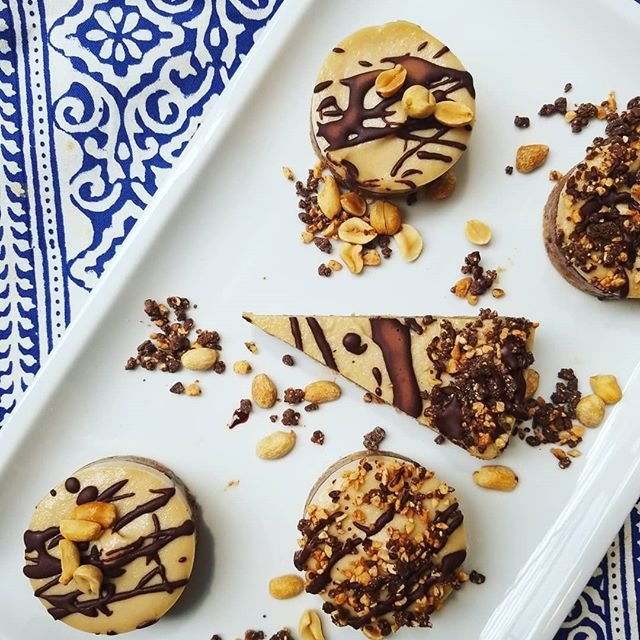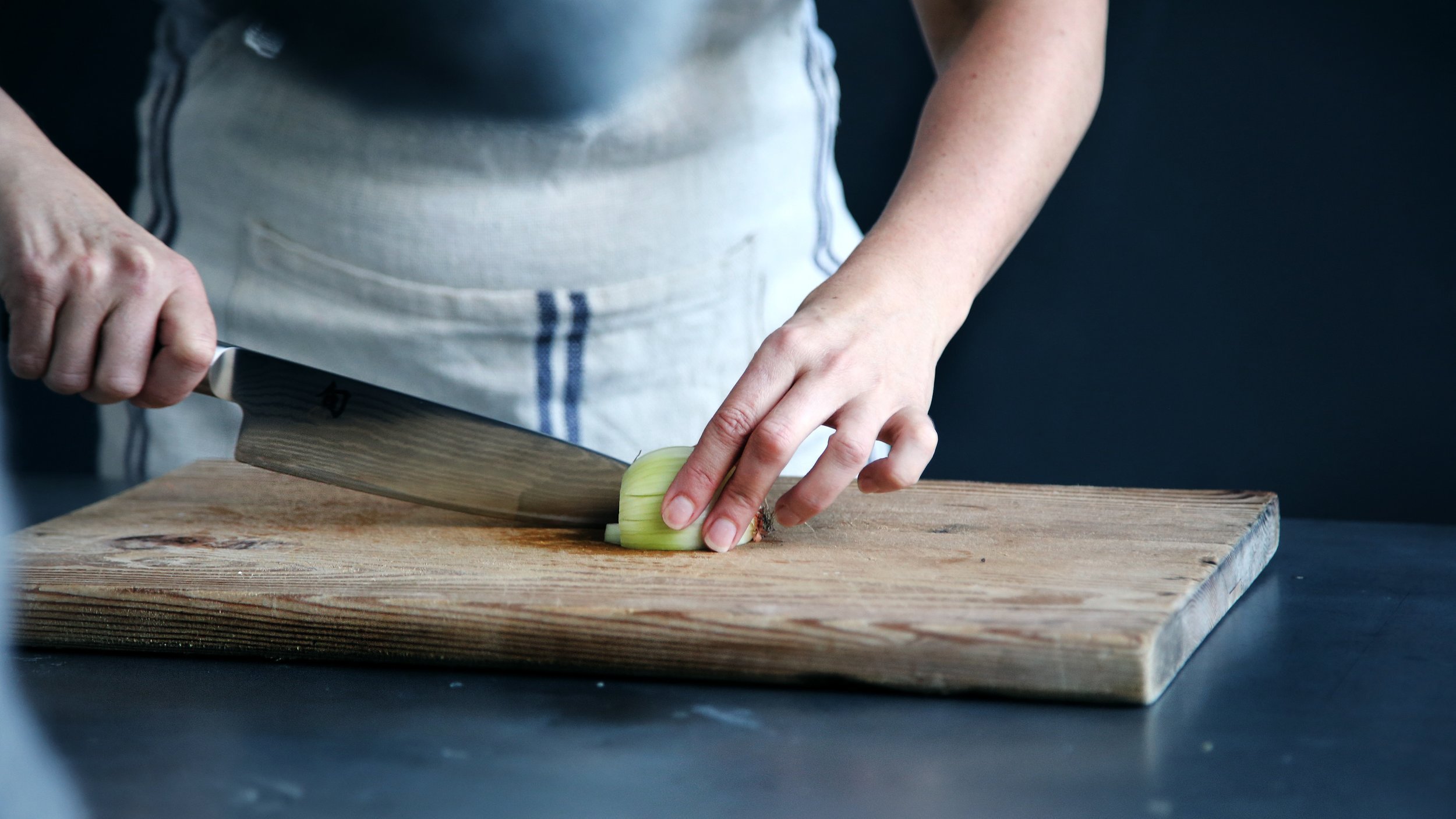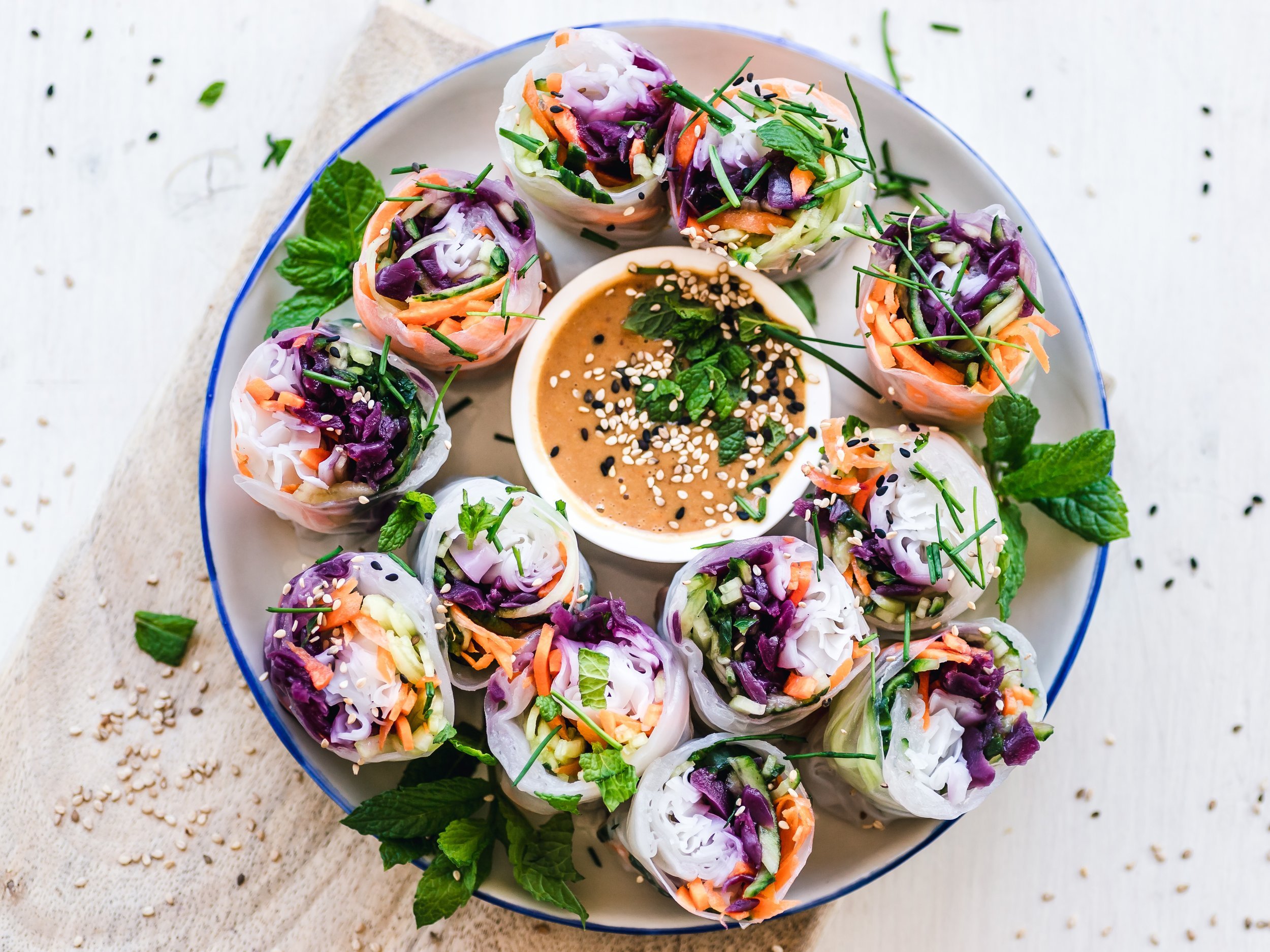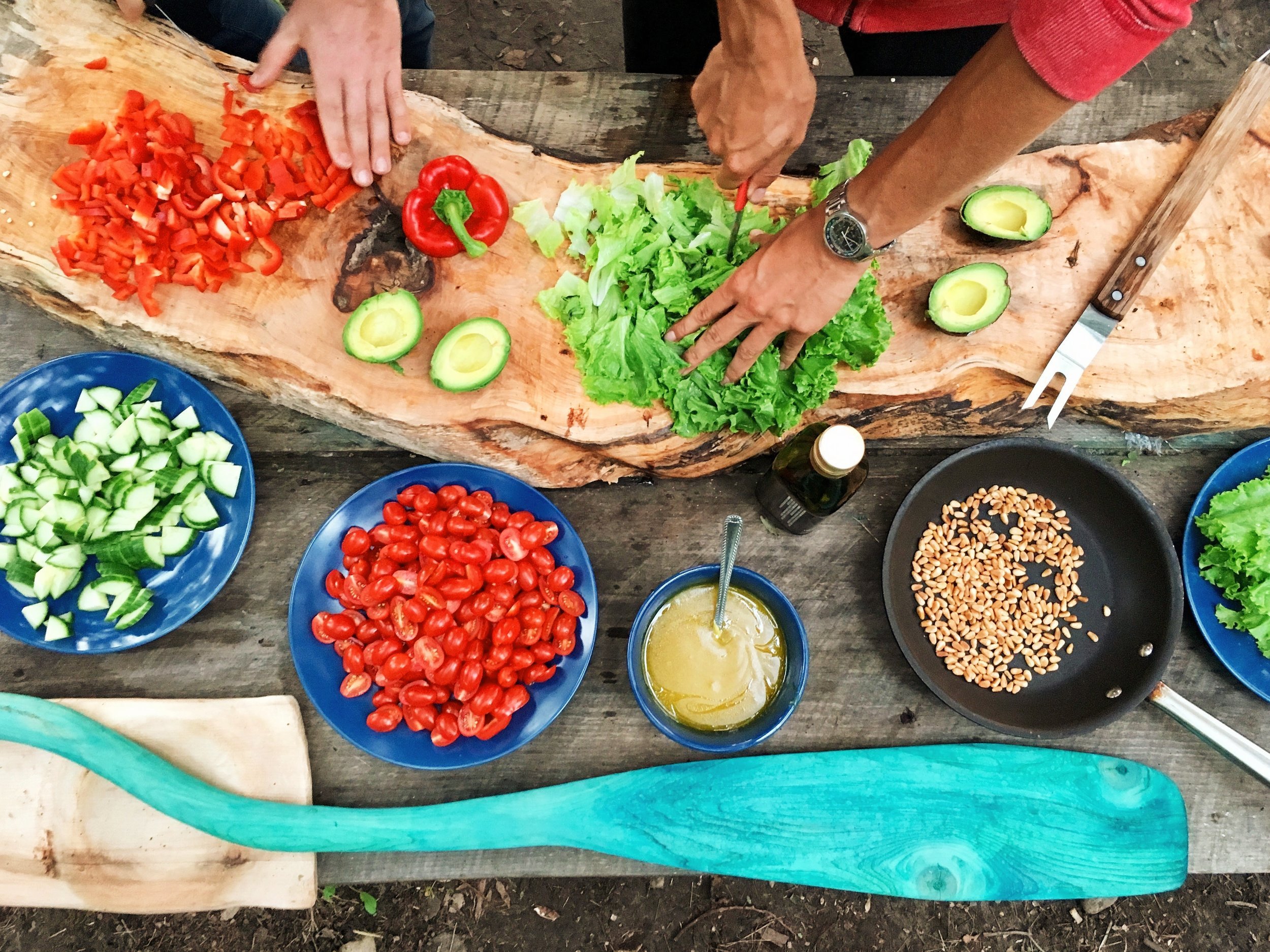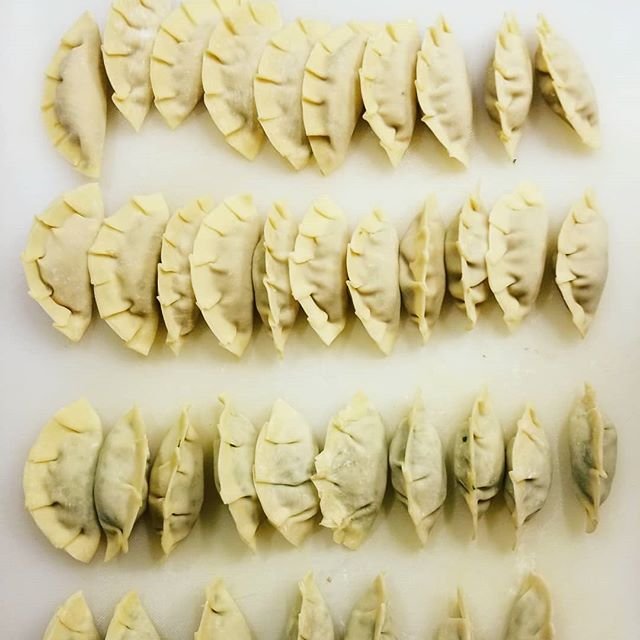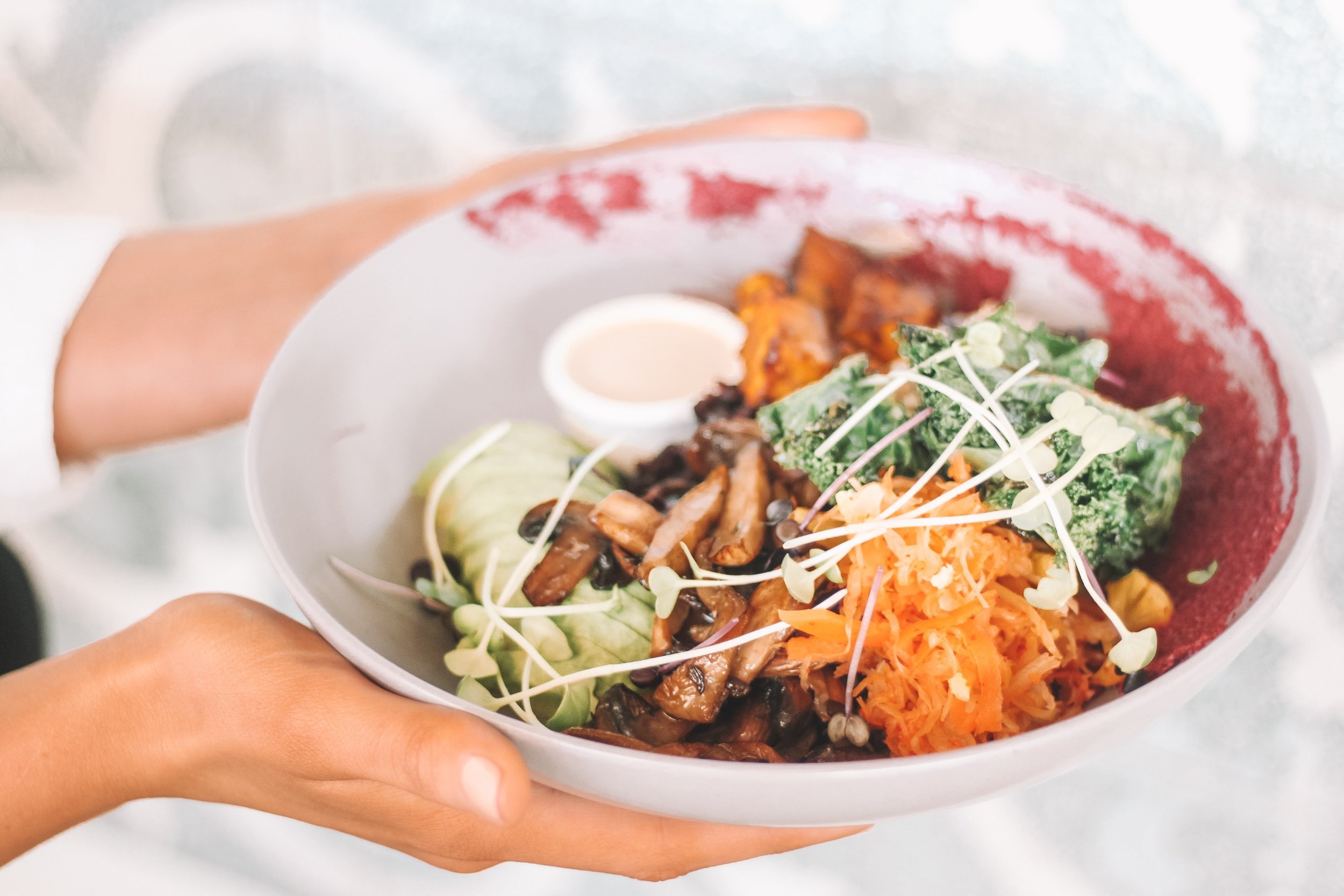Grain-Free Carrot cake with Vegan Cream Cheese Frosting
“Freedom is... not to be bound by my wounds. And to be able to eat cake every day.”
CARROT CAKE IS BACK IN BUT WITH A MODERN TWIST
Well, it seems carrot cake is back in style! Every time I go on social media lately, I see dozens of versions of carrot cake resurfacing from the 1970’s. It’s as if the millennial generation is just discovering the deliciousness of carrots in desserts while my generation is finally understanding why our parents were so keen on it. I wonder, why didn’t it survive the 2000’s? Ah, yes… the Rise and Fall of the Cupcake fad.
But like many other classic recipes, it was time to bring Carrot Cake into 2021 in due fashion: by omitting gluten and dairy! Yes, its beyond do-able and yes, its so, so delicious. While we didn’t pipe little carrots and their tops around the border, we did pile on a confetti of heirloom carrots on as ribbons, shavings, and coins, and added a seasonal garnish- local bee pollen!
WHY I LOVE THIS RECIPE:
This gluten-free + dairy-free carrot cake is ridiculously tender, perfectly spiced, lightly sweet, and is super easy to make.
I LOVE that I can take it to a party, knowing that most dietary restrictions and allergies are covered being free from gluten, dairy, soy, corn, refined sugar, and lectins.
Clean-up is a breeze as you will not need an electric mixer!
You can eat it for breakfast. And I did. Many times! This carrot cake recipe is low in sugar but high in protein and fiber, thanks to my gluten-free flour blend of almond meal + coconut flour and reduction of sugar from most cake recipes. Instead, we highlight the natural sweetness of carrots, dried fruit, and pure maple.
The icing is made with an amazing almond-based cream cheese by Kite Hill. It mixes easily with coconut cream, vanilla, and sweetener to taste. Most haven’t heard of the newly available soy-free cheeses, so its a great conversation piece.
You can make an art project out of it. Use shavings of rainbow carrots in their myriad of colors, seasonal edible flowers like pansies or marigolds, and local bee pollen for a honey crunch. Kids, especially, love this part.
Whenever I test a recipe for a new dessert, I start with half the amount of sugar as the base recipe ratio. Our palates are so accustomed to sweetness - addicted, really - that we rarely think of omitting it. While many recipes need a certain ratio of sugar to achieve a specific texture, cakes are more forgivable. The sweetener used - maple syrup- is naturally sweeter and therefore you will not need to add as much to please the palate. Additionally, in its liquid state, it keeps the cake moist for longer. Win, win!
PRO-TIPS:
Bring ingredients to room Temperature. This ensures your batter wont cease up when mixing dry + wet ingredients
Vegan eggs. The recipe calls for chicken eggs but you may use flax eggs: 1 flax egg = 1 Tbl ground Flax seed + 2.5 Tbls water. Let sit 5 minutes. You may also use an egg replacer that includes a binder, but I prefer not adding unnecessary starches.
For carrot ribbons and coins, use a Benriner mandoline and store in ice water; for shredded, use a box grater. As always, use caution with these tools.
As with all GF baking, silicone is best. Silicone pans and molds are best for my gluten-free recipes as it allows the higher-protein almond + coconut flour batter to properly rise and I prefer the lighter texture resulting from that.
Binders are optional. Many gluten-free flour blends contain gums and starches to bind (more on gluten-free flour blends further along in the blog). While this may be preferred with vegan baking, this recipe has eggs and will not need it. If you choose vegan baking, add 1/2 tsp xanthan gum to your dry ingredients.
KEEP READING TO LEARN THE THE HISTORY OF THE GLUTEN-FREE TREND AND THE IMPORTANT DIFFERENCE BETWEEN GLUTEN-FREE FLOUR BLENDS OR GET THE RECIPE NOW BY CLICKING THE DOWNLOAD BUTTON BELOW. DON’T FORGET TO SUBSCRIBE FOR OTHER AMAZING, HEALTHY, GLUTEN-FREE RECIPES!
The low-down on the best gluten-free flour blends, sugar absorption, and why this matters:
My husband Philip will attest to the fact that I attempt to incorporate an insane amount of vegetables at every meal including smoothies and cakes. The inclusion of nutrient-dense whole foods while minimizing processed foods is not only my personal health template, but one I encourage in my business with my cooking and nutrition clients alike.
This led me to researching the best ingredients for gluten-free baking. Have you ever looked at the nutrition facts label on the packages of gluten-free cookies, cakes, crackers, and mixes? Being a Nutritionist, I am appalled by the amount sugar and carbohydrates (from starch) they contain while containing so little fiber and protein. The three types of carbohydrates are sugar, starch and fiber. During the digestive process, both sugars and starches are turned into the sugars that the body uses for energy. People lack the enzymes needed to digest fiber, so it passes through the digestive tract without turning into to sugar and heading to colon where it bulks up stool, helps improve motility and slows digestion. This means you stay full longer. Ideally, we consume foods that are low on the glycemic index (a measurement of how high a food spikes blood sugar) and contain fiber, fat, and protein to slow digestion. This is why I love almond flour + coconut flour: low on the glycemic index, high in fiber and protein. Yet, the most popular substitution for glutinous flour is a cost-effective combination of starches like rice flour, tapioca flour, potato starch, xanthan gum, garbanzo bean flour, and cornstarch: all much higher on the glycemic index. All plants form starches, which are also called complex carbohydrates, by stringing together sugars. But when you eat starchy foods, the starches are broken down into sugars, including glucose, maltotriose and maltose, by an enzyme called amylase found in your saliva and small intestine. These compound sugars are further broken down into simple sugars by other enzymes, including maltase, lactase, sucrase and isomaltase. Without enough fiber and protein like that in almonds and coconut to keep you full, you could be craving more sweets sooner- just one fun side-effect of many when consuming foods higher in sugar! Furthermore, almond and coconut are 2 amazing foods on a long list that are low in inflammatory compounds, while tapioca, bean, potato, and corn starches all contain lectins- plant compounds used as a defense mechanism- that can cause inflammation throughout the body, especially in the digestive tract. Consider the fact that most of us eat these foods every day! It is not enough that we choose a gluten-free diet (if you do), but which foods we choose to consume while on it. Even gluten proteins contain higher protein and fiber content than starch flours.
Take a look at the images below. They are nutrition labels for two different flours reflecting the same volume. The image on the right is a very popular gluten-free flour blend and the image on the left is almond flour (almond meal). Combine almond flour with coconut flour (as I do with my blend), and you further increase the protein + fiber ratio to sugar which can keep you satisfied longer. You will see that almond flour has only 5g of carbohydrates from almonds in 1/4 cup, with 3g of those being fiber leaving only 2g of plant sugars to be absorbed as simple sugars. The gluten-free flour blend, however, contains 25g of carbohydrates from starches in 1/4 cup, with just 4g of fiber, leaving 21g of plant sugars to be absorbed as simple sugars. Many know this equation as finding the ‘net carbs’: Total Carbohydrates in grams minus fiber in grams equals ‘net carbs’.
THE GROWING DEMAND FOR PERSONALIZED DIETS:
Growing up, we had carrot cake once a year- on my Dad’s birthday. I was a freakish kid who loved vegetables and salad so, of course, carrots in a cake wasn’t off-putting to me at all. What was aghast to me however, was the fluffy, overly sweet icing that overpowered the entire cake. I would then end up with a ‘tummy ache’ because it was made of dairy. Who wants a whiny kid (or adult) around on such a joyous occasion puking on presents? No one. Who made a dairy-free carrot cake in the 1980’s? I have little clue but it sure as hell wasn’t our household or anyone we knew.
Over the past few decades, we have seen a phenomenon that wasn’t a priority in past generations who suffered through the Depression era and their children: the personalized diet. Could you imagine during times of famine exclaiming you consume a gluten-free diet? Food was food and its supply was scarce. I try never to judge in respect to low-income homes building up towards an organic lifestyle or areas of the world who are fed (pun intended) incorrect information about nutrition, diet, and lifestyle. We only know what we know and, oftentimes, only what our community and local government shares with us through schools, ads, billboards, and restaurant chains that are allowed to pop up wherever there is land. Let us flash back to the impressive rejection and closing of a McDonald’s in inner-city Rome and the great Seattle fast-food strike of 2013! That strike was originally based on wage fairness but ultimately resulted in many fast-food chains shutting down city-wide. This left the neighborhood councils to rethink their gastronomical influences and invest in higher quality dining establishments. The People realized the power they held.
Citizens are discovering that what they put in their mouths actually matters to the rest of their body: the epiphany of individual needs
I was lucky enough to grow up the a progressive area of the Pacific Northwest- a health mecca, of sorts -where a ‘natural foods’ store was most likely within a 10 mile radius. The health-conscious could easily find every seasonal vegetable, new supplement, and diet fad ingredient easily, to create healthy and balanced meals at home. Interestingly however, most of that seemed to be left at the restaurant doorstep. While there were several vegetarian restaurants in the area, none that I knew of were personalized. I spent my entire 20’s immersed in downtown Seattle, cooking in fine dining establishments that generally ignored substitutions and special requests. That was until 2010, where I found myself running the tasting menu kitchen of Mistral Kitchen with free reign. Unlike kitchens before, I allowed guests to tailor their menus based on their dietary need, restriction, and allergy without the awkward conversations and requests. I thoroughly enjoyed crafting each dish to the unique need of each guest. Their dining experience began with, “Are there any allergies, dietary preferences, or restrictions you would like your menu to reflect this evening?”. How the guest felt physically and mentally after a meal was just as important to me as how great of a time they had. After 8 courses, they may not remember everything they ate, but they would remember how they felt.
THEIR DINING EXPERIENCE BEGAN WITH, “ARE THERE ANY ALLERGIES, DIETARY PREFERENCES, OR RESTRICTIONS YOU WOULD LIKE YOUR MENU TO REFLECT THIS EVENING?”
Evidence of the Gluten-free fad began popping up around 2012 - coincidentally when I began my Nutrition Studies at Hawthorn University. It is nothing new that glutinous grains have been a culprit of ailments. Records of mysterious illnesses (that have since been traced back to early cultivation of wheat) date back to 250 AD. Discovery of the Celiac gene (gluten protein allergy) was discovered in the 1970’s, with acknowledgement of non-Celiac Gluten Sensitivity in the 1980’s. It wasn’t until Alessio Fasano, director of the Center for Celiac Research and Treatment at Massachusetts General Hospital, published a 2003 study in the journal JAMA Internal Medicine that found that Celiac disease was present in around 1% of the population of the United States, or 10 times higher than what people thought it was. Since, more evidence has come out that a gluten-free diet could potentially benefit people suffering from chronic inflammatory conditions, like diabetes, schizophrenia, autism, and multiple sclerosis. As much evidence is mounting, there are still skeptics. Nevertheless, the gluten-free industry has risen to over $10.5 billion and encompasses gluten-free apps, supplements, cookbooks, restaurants, bakeries, support groups, and meal delivery, and is now FDA mandated labels on foods tested to be gluten-free.
This does not mean I advocate replacing your daily consumption of cake with store-bought, processed gluten-free cakes and cookies. Remember, starches from plants break down as (potentially harmful) sugars, too. We need to switch our mindsets from thinking we can replace a poor diet choice with something that is just slightly less bad for us (would someone please cease making things like Halo Top? “Not as bad” does not equal “Good for you”). We need to get into the mindset of removing highly processed ingredients completely and using products close to nature to create our own foods.
Opinions aside, gluten-containing products are highly processed crops ( and if conventionally-grown, sprayed with pesticides that are wreaking havoc on our health). I do believe everyone could benefit from at least switching a cake or two a year to grain-free! So, why wouldn’t we make one that reflects most dietary restrictions? I, for one, would prefer to make one accessible for all.


